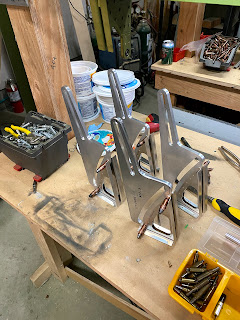Flap bellcranks are assembled, and in their mounts. Next step is to build the flap cable pulley that goes behind the aft spar. At this point, clearances need to be checked to verify the cables will go through the holes on the spars. I used nylon line for my weed trimmer.
I can't say enough about having both wings going at the same time... It is more than twice as fast from a build perspective. The first one (in my case) usually involves some learning, or jigging, or swearing... while the 2nd one goes much faster.
Attach angles for the flap brackets. These are very fiddly to make.
Finally... reassembly time! Ribs starting to go back in...
Main ribs 1 and 2 need to be riveted together... I used the C frame for these... makes a nice job and is very quick.
All ribs installed and riveted. The cap strips under the forward spar are clecoed in place for when the nose skins go on.
Speaking of nose skins... I made some jigs to hold the skins while riveting. I clamp these to the bench. Worked very well - keeps the entire assembly held firmly. I can also use the cut outs to clamp the piece into place very firmly, but haven't seemed to need this.
Had some issues with the flush riveting... I have done a bit of this in the past, but never this much, and never on a curved surface. The squeezed rivets (aft most rivet hole top and bottom, and the end ribs can be squeezed - more if you have a longer yoke) were good, but the bucked rivets were slightly proud. So after tiring of drilling out rivets, I asked from fellow builders for some advice.
Seems like I was putting too much pressure on the bucking bar, and not enough on the manufacturer head. This seemed to address the issue. I am using a small tungsten bar on the interior of the assembly.
I moved the assembly from side to side in the alley between the wings. Luckily I could do this on my own. Simply remove all the jigs except one on each end, and move one end at a time. When the assembly is all 3 nose skins (16' long), it is rather wobbly.
First nose skin in place.... but I missed one rivet... so it will have to come back down once the other side is done.
2nd nose skin in process. The first one took me 3 partial days.... the 2nd one was 80% completed in about 2 hours. Probably 3 hours total. Building both wings at the same time is the way to do it, no doubt.
Once these two nose assemblies are done, they will need to be inspected before I can move forward. Submitted the paperwork on 12/31/2019. Happy New Years eve!
Next steps:
- Finish nose skin / rib assemblies
- Rivet nose skin / rib assemblies to forward spar
- Alodyne / prime main skins
- Fabricate lower flap track angles
- Cut slots in lower main skins for flap tracks
- Rivets lower main skins



























